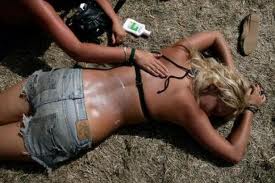To make the right choice of sunscreen consumers need to be well informed of the degree and nature of protection that a particular product offers and how well it meets the need of their skin to be protected against sunlight. This is important because unprotected exposure to the UV rays is a determinant of cancer as most of you already know. According to American Cancer Society Cancer is primarily an effect for the UVA rays, while the UVB rays are responsible for sunburns.Problems with Available Sunscreen
Unfortunately, there are some serious problems with the available sun screen lotions, which have been addressed recently.
Vitamin A
EWG research has demonstrated that Vitamin A additives actually contribute to the development of cancer. The sun screen lotions usually contain Vitamin A as it is an anti-oxidant: has anti-aging properties. Research has unveiled that when exposed to sunlight the same vitamin may result in the development of carcinoma due to its photo-carcinogenic nature.

Deceptive Labels
FDA considers labels on popular sunscreen products such as “sun block”, “waterproof” and a label of SPF over 50 as “an exaggeration of performance”. Such labels are misleading as no sunscreen is available in the United States that offers complete protection.
FDA Defines Strict Standards.
The Food and Drug Administration, USA, has defined a new standard for sunscreens on the 14th of June, 2011.
- Sunscreens will not be labeled over SPF 50 unless there is an evidence of advanced protection.
- There has to be a ‘drug facts box’ providing detailed information of the nature of the sunscreen and what kind of protection is needed, providing the customers with informed choices.
- Sunscreens with SPF under 15 will have to be labeled as a guard against sun burns only; it needs to be mentioned that they neither have anti-aging properties and nor do they provide protection against cancer.
- Sunscreens providing protection against UVA and UVB rays need to be labeled “Broad Spectrum” and the label/drug facts box has to include the statement ‘used as directed reduces the risk of early skin aging and skin cancer when used with other sun protection measures’.
- The labels would include a 4-star rating reflecting the degree of protection the product offers, where 4 starts would represent highest protection, and one star would mean low protection.
- The drug facts box will also inform people of further protective measures such as clothing and limited exposure to sunlight.
A Take-home Message
As it would take time for the above to take effect, for the time being, make sure you go for a sunscreen with an SPF of at least 30, and that it offers protection against both UVA and UVB rays.